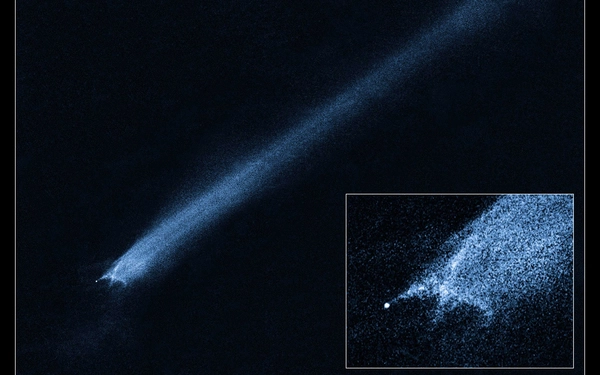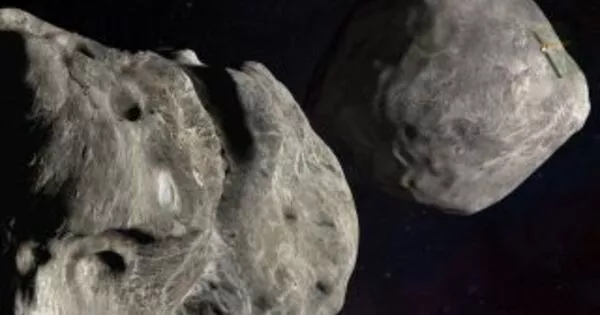DART (Double Asteroid Redirection Test) is a space mission led by NASA that aims to test whether it is possible to deflect an asteroid on a collision course with Earth. The mission involves the launch of a spacecraft, which will collide with the moon of an asteroid system called Didymos, located about 11 million kilometers away from Earth. The collision is expected to change the orbit of the moon, thus testing the effectiveness of the impact as a means of asteroid deflection.
In 2022, NASA embarked on a risky experiment to see if they could change the velocity of an asteroid by smacking it with a ballistic probe, similar to hitting it with a hammer. This experiment was designed to put to the test a potential technique for deflecting an asteroid on a collision course with Earth. Perhaps, for the first time in the universe’s history, an intelligent planetary species sought ways to avoid extinction due to threats from outer space (something the dinosaurs, who were wiped out 65 million years ago by a rogue asteroid, never evolved to accomplish).
Like a sports photographer at an auto-racing event, NASA’s Hubble Space Telescope captured a series of photos of asteroid Dimorphos when it was deliberately hit by a 1,200-pound NASA spacecraft called DART on September 26, 2022.
The primary goal of DART, which stands for Double Asteroid Redirection Test, was to assess our ability to change the trajectory of the asteroid as it orbited its larger companion asteroid, Didymos. Though neither Didymos nor Dimorphos pose a threat to Earth, the mission’s data will assist researchers in determining how to potentially divert an asteroid’s path away from Earth if necessary. The DART experiment also revealed new information about planetary collisions, which may have been common in the early solar system.
The DART impact happened in a binary asteroid system. We’ve never witnessed an object collide with an asteroid in a binary asteroid system before in real time, and it’s really surprising.
Jian-Yang Li
Hubble’s time-lapse video of the aftermath of the DART collision reveals astonishing hour-by-hour changes as dust and debris were flung into space. The DART impactor smashed into the asteroid head on at 13,000 miles per hour, ejecting over 1,000 tons of dust and rock.
The Hubble film provides invaluable new insights into how debris was dispersed into a complex pattern in the days after the impact. This occurred over a much larger volume of space than the LICIACube cubesat, which flew past the binary asteroid minutes after DART’s impact.
“The DART impact happened in a binary asteroid system. We’ve never witnessed an object collide with an asteroid in a binary asteroid system before in real time, and it’s really surprising. I think it’s fantastic. Too much stuff is going on here. It’s going to take some time to figure out,” said Jian-Yang Li of the Planetary Science Institute in Tucson, Arizona. The study, led by Li along with 63 other DART team members, was published in the journal Nature.

The movie shows three overlapping stages of the impact aftermath: the formation of an ejecta cone, the spiral swirl of debris caught up along the asteroid’s orbit about its companion asteroid, and the tail swept behind the asteroid by the pressure of sunlight (resembling a windsock caught in a breeze).
The Hubble movie begins 1.3 hours before impact. Didymos and Dimorphos are both within the central bright spot in this view; even Hubble cannot resolve the two asteroids separately. The thin, straight spikes projecting from the center (and visible in later images) are artifacts of Hubble’s optics. The first post-impact snapshot is taken two hours after the event. Debris flies away from the asteroid at speeds greater than four miles per hour (fast enough to escape the asteroid’s gravitational pull and not fall back onto the asteroid). The ejecta forms a mostly hollow cone with long, stringy filaments.
The debris pattern entered a second stage about 17 hours after the impact. The dynamic interaction within the binary system begins to distort the ejecta pattern’s cone shape. The most noticeable structures are rotating, pinwheel-shaped elements. Didymos, the companion asteroid, exerts gravitational pull on the pinwheel. “This is very unusual for this incident,” Li said. “I couldn’t believe these features when I first saw them. I assumed the image was smudged or something.”
The debris is then captured by Hubble as it is swept back into a comet-like tail by the pressure of sunlight on the tiny dust particles. This expands into a debris train, with the lightest particles traveling the fastest and furthest away from the asteroid. Later, Hubble records the tail splitting in two for a few days, adding to the mystery.





